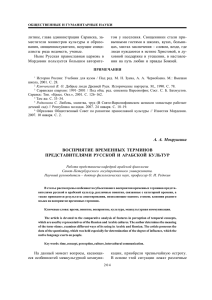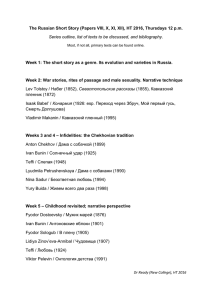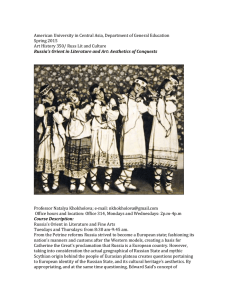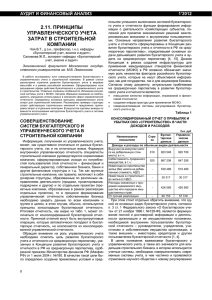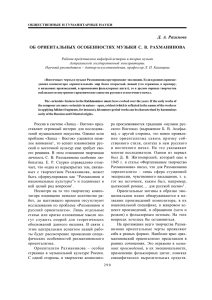Russian Trace in the Family History and Work of Alexander Grothendieck
advertisement

Dedicated to Ivan Alexandrovich Panin 1 Russian trace in the family history and work of Alexander Grothendieck Mikhail Gavrilovich, Konstantin Pimenov ∗, Elena Volk 16 августа 2020 г. Аннотация Based on records in Russian archives, we present some new facts about life of Alexander Grothendieck’s father in Russia and his anarchism activities. We found his name at birth and that he had at least three brothers. Moreover, we found the fate of his eldest son, David Aleksandrovich Shapiro, a prominent petrophysicist, and established contact with his daughter. Notably, in mid-90s David Shapiro has dictated several pages of memories about his parents which are now kept by his daughter. In this note, based on archival documents, we will supplement and clarify information about father Alexander Grothendieck, most of whom contained in the biography of Grothendieck, written by U. Sharlau [1]. We managed to establish the real name, given at birth to Alexander Petrovich Shapiro and establish with certainty that he did not less than three brothers. In addition, we found out the fate of A.P. Shapiro’s eldest son, David Alexandrovich, and established contact with his daughter. In the mid-90s, D.A. Shapiro dictated to her several pages of memoirs about his parents, where he told the real name of his father, grandmother, the history of acquaintance of parents and other information that he knew from the words of his mother. 1 Introduction Winfried Scharlau has currently published two of the four planned parts of the biography of Alexander Grothendieck. The first of the four parts of Scharlau’s book [1] is dedicated to Grothendieck’s origins, childhood and youth. Alexander Grothendieck was the son of an anarchist couple: Hanka Grothendieck, who came from a German burgher family, and a former Russian citizen known as Alexander Petrovich Shapiro or "SashaPetr". It turned out that although Winfried Scharlau managed to find numerous documents concerning the Hankey Grothendieck family in the German archives, he nevertheless could not find documentary information about Grothendieck’s father, with the exception of a few items related to the registration of a residence permit in Berlin, in which Grothendieck’s father appears under the name "Tanaroff". The main ∗ The second author is supported by RFBR grant 16-01-00750 "Motivic and classical methods in Algebraic group theory, Algebraic geometry and Number Theory" 2 source of information about Grothendieck’s father for Scharlau was the voluminous manuscript of Hanka Grothendieck’s autobiographical novel, as well as some documents from Grothendieck’s personal archive, including several letters and photographs sent from the Soviet Union in the 1920s and early 1930s. However, prior to our research it was not completely known whether the surname "Shapiro"was the real surname of Grothendieck’s father or one of the conspiratorial pseudonyms. In the documents from the various Russian state archives, we managed to find the real name given to "Alexander Petrovich"Shapiro at birth, and find out that he had at least three siblings. Moreover, the fate of A.P. Shapiro’s eldest son, David Alexandrovich ("Dodik"), became known to us, and we established contact with his daughter. In the mid-90s D.A. Shapiro dictated to his daughter several pages of memoirs about his parents. He mentioned there, among other things, the real name of his father and other information about him; most of this information is based on the stories of his mother. In the second half of 1921 A.P. Shapiro managed to escape abroad. By that time, his son was 2.5 years old, and they never saw each other. In the main part od our paper, we compare mentioned above sources, archival and memoir, and try to trace the life series of events of Grothendieck’s father on the Russian territory. Grothendieck himself never visited the Soviet Union and the Russian Federation. In the early 80s, as we know based upon the words of Grothedieck’s then life partner, whom Scharlau interviewed, he was obsessed with finding his half-brother. When his girlfriend was on a tourist trip to Leningrad, Grothendieck provided her with detailed instructions, but the mission was not fulfilled. In 2018, we managed to fulfill Grothendieck’s dream and find not exactly his half-brother David, but his daughters. The daughter and granddaughter of David Alexandrovich visited the village of Lassere in the Pyrenees, the grave of Grothendieck and met their relatives — the children of Grothendieck. section What Russian mathematicians did for Grothendieck In the process of working on this historical and biographical research, the first and second authors discovered that no one in open sources have analyzed the history of Grothendieck’s contacts with Russian mathematicians. We are aware that Alexander Grothendieck himself, being a citizen of the world and an enemy of states by convictions, would categorically object to the investigation like this. Moreover, according to Pierre Cartier personal conversation with the first author, Grothendieck repeatedly mentioned that his father called himself "Ukrainian thereby emphasizing both the break with traditional Jewish culture and the failure to recognize oneself as a representative of Russian society. Nevertheless, the artificial narrowing of the point of view on the work of Grothendieck and the biography of his family according to the geography, allows you to embrace the immensity and formulate some observations. Yuri Ivanovich Manin in 2014, during the lifetime of Alexander Grothendieck, wrote a note [2] where he remembers his six to seven weeks visit to Paris in 1967, which is partly resulted in the work [3]. This was the first work on the Theory of Motifs published in any language. Grothendieck recommended it to Mumford as a wonderful exposition of the foundations of the theory, and in early 1969 he sent Yuri Ivanovich a letter in Russian with words of gratitude for this work. Although the works of Yu.I. Manin, especially on the Brauer group, were mentioned in the correspondence between Serre and Grothendieck as early as in the first half of the 60s, apparently from 1967 a period of indirect but fruitful collaboration between Grothendieck and the Shafarevich school should be counted. The most striking example of the deep inner connection between Grothendieck 3 and the Shafarevich school was the discovery by Gennady Bely in 1979 about three branch points on an algebraic curve defined over the number field [4]. This work aroused Grothendieck’s admiration; it turned out that Grothendieck had suggested a similar step towards the description of the absolute Galois group of the field of rational numbers a few months before his acquaintance with Bely’s work. In the 80s, Moscow turned out to be one of the few places, along with Bangor in Wales, where they took seriously Grothendieck’s theory of "Dessin d’Enfants"which remained unpublished in traditional ways as well as his works on anabelian geometry and n-categories. Therefor, Manin Seminar and Gelfand Seminar in Moscow played an important role in the recognition of these works by the mathematical community. According to Mikhail Kapranov response to a question stated by Ron Brown in a personal letter, an excerpt from which was published by the latter on the website https://groupoids.org.uk/ pstacks.html "From what I remember, Gelfand advocated reading both Esquisse and Pursuing stacks. Voevodsky was very interested in both anabelian geometry and higher stacks. Drinfeld was influenced by Esquisse in his paper on"Drinfeld associator "and a version of the Grothendieck-Teichmueller group appearing in the theory of quasi-Hopf algebras. This is probably the most serious influence on Soviet mathematics of the period ". Strikingly, "Dessin d’enfants"theory turned out to be closely related through the Anabelian program to the Theory of Motifs and Motivic Galois group . The GrothendieckTeichmüller group appeared in the regular mathematical press for the first time in the work of V.Drinfeld [5], published in Russian. Thus, it was due to Vladimir Drinfeld this fragment of of ideas emerging in 80s in Grothendieck’s manuscripts of the 80s was accepted by the world mathematical community. The name of Vladimir Voevodsky in the mathematical community neighbours very often with a Grothendieck’s name. Voevodsky realized one important dream of Grothendieck: he built a category of motives. According to I.A. Panin, Grothendieck, back in the 1960s, believed that in algebraic geometry there should be analogs of all those classical generalized cohomology theories that occur in topology. The door which open the way to this new world, predicted by Grothendieck, was invented by Voevodsky. By an amazing coincidence, the first published work of V.Voevodsky (joint with G. Shabat) was devoted to Grothendieck’s "Dessin d’enfants"theory and was published in a volume dedicated for Grothendieck’s 60th birthday. G. Shabat recalls this episode and Grothendieck’s reply to their letter in an interview celebrating life of V.Voevodsky in the newspaper "Troitsky Variant"[6]. At the same time, back in the Soviet times, Voevodsky and Kapranov wrote a work dedicated to Grothendieck’s motto "homotopy type is an infinity-grupoid". Later, an error was discovered in this work, which is considered one of the impulses that prompted V.Voevodsky to launch up the main project of his last ten years: the homotopy type theory. The realization of Grothendieck’s motto, its transformation into theorems was a story continued for thirty years and this story still awaits a thorough historical and mathematical analysis. Ron Brown, in the source cited above gives a wonderful summary of the "Pursuing Stacks"origins and the history of Grothendieck’s interaction with Bangor School of Category Theory since 1970, which was only slightly covered in the third part of Grothendieck’s biopgraphy by W. Sharlau. Although Russian mathematicians did not play a key role in transforming Grothendieck’s above motto into theorems, Voevodsky’s interest in ∞-categories, "Dessin d’enfants" and Theory of Motifs is, to say the least, remarkable. After reading several interviews, the parallels between Vladimir Voevodsky and Alexander Grothendieck seem to be much deeper, rather than just a community of mathematical interests. They both 4 spoke and wrote boldly about their transcendental experiences. Both were intolerant of falsehood and did not accept the "rules of the game"imposed by society, which contradicts to their inner convictions. Colleagues close to V. Voevodsky note his inherent inner freedom, and the very same feature was belonged to to Alexander Grothendieck. Voevodsky was not a dissident or anti-Soviet in the late USSR, but he managed to be absolutely "non-systemic". In addition to the school of Shafarevich and Manin, we oblige to mention what connects Grothendieck and the city on the Neva, where his father spent the first happy months after release from the Czar’s prison. As a matter of fact, Leningrad/Petersburg became one of the world capitals of algebraic K-theory, which was actually created by Grothendieck as a subject. Although, there are no historical evidences that Grothendieck anticipated the generalization of the Riemann-Roch-Hirzebruch-Grothendieck theorem in the form of I.A. Panin and A.L. Smirnov, but we have no doubt that he personally would have liked this generalization very much. Firstly, in the general context of oriented cohomology theories proposed by Panin and Smirnov, the Riemann-Roch theorem acquires a transparent and almost trivial meaning, which is described by the verbal formula "change of variable during integration". Secondly, the concept of oriented cohomology theories has a deep connection with transfers and correspondences, which underlie Grothendieck and Voevodsky’s theory of motives. Therefore, we dare to claim that I.A. Panin and A.L. Smirnov have realized one Grothendieck’s unformulated dream. 2 Item from the The Society of Former Political Prisoners and Exiled Settlers fund In the State Archives of the Russian Federation (hereinafter referred to as GARF) in f.№533 (All-Union Society of Political Prisoners and Exiled Settlers), op.№3 "Personal affairs of former political prisoners expelled from society, as well as those not accepted into society (1921-1935)"the file "Shapiro Alexander Petrovich (Sasha)"is occupied seven pages, which contain the following information: 1. The questionnaire completed by "Sasha-Petr"[7, pp.1,1v], which indicates the place of birth, places of trial and serving of imprisonment, dates and occupation of revolutionary activity; 2. "Sasha-Petr“s handwritten application dateq August 2, 1921 for membership in the society [7, p.5]; 3. Reference from the Leningrad archive dated December 14, 1928 about the presence of a record about Surazh city petit-bourgeois Iosel Shaev Shapiro in the Criminal Record Bulletin per 1909 [7, p.3]; 4. An envelope addressed to A.P. Shapiro in May 1925 at Bol. Afanasyevsky pereulok 30, apt. 1, which returned for the missing of the addressee. Consequently, after reregistering members of the society on August 1, 1925, A.P. Shapiro mechanically was excluded from it. This file is the first source where we found the name "Iosel Shaev" with reference to the city of Surazh, Chernigov province (in 1919-1926 Surazh belonged to the Gomel province, now to the Bryansk region of the Russian Federation; not to be confused with the city of Surazh in Vitebsk province). 5 In the Russian Empire, Criminal Records Bulletins compiled by the Ministry of Justice were published annually. Most of these Bulletins are now available online at the Russian State Library website. In the Bulletin per 1909 there is an entry [10, p.519] "Shapiro Iesel Shaev, Surazh petite-bourgeois, 17 years old, was convicted by the Mogilev District Court on May 30, 1909 under Articles 134, 135, 139, 1629 and 1632 of the Penal Code and sentenced to 5 years and 4 months of hard labor. The sentence came into effect on December 7, 1909." The archival reference requested by the Society of Political Prisoners in 1928 was apparently compiled on the basis of the same record [10, p.519]. In the questionnaire "Sasha-Petr" indicated the year of his birth as 1889, profession (locksmith), and noted that he spent three years in a common cell before escaping. He also indicated that he was arrested in June 1917 during the events at Durnovo’s dacha in Petrograd, and then in December 1919, he was arrested in Samara as connected to the Explosion in Leontief Lane. In the same questionnaire, it is indicated that, according to the last sentence, he spent a total of 4 years in the Oryol and Yaroslavl Central prisons. We will return to the known details of his imprisonment later. Let us note that one of the two recommendations required for admission to the Society of Political Prisoners was written in the form of a resolution on A.P. Shapiro’s questionnaire were signed by I. Ya. Korotkov. We have not yet been able to establish who signed the second recommendation. Ivan Yakovlevich Korotkov (b. 1886) raised in a peasant family, became a member of the Socialist Revolutionary Party, and published his memoirs as part of the book [11], where on page 43 there is the following paragraph: "Then I remembered what I had written in the punishment cell a poem dedicated to the memory of Yegor Sozonov and I sang it. After the punishment cell I was transferred to the same large cell with capacity of sixteen situated in the empty building. There was as much air as you like, and there was even more cold and dampness than in the punishment cell. I was warmed up here only then when, dressed in a pea jacket, wrapped his head in a blanket. Anarchist Shapiro, who lived with me for several months, was transferred to my cell. After Shapiro, I had, though not for very long, a rather difficult roommate ... ". It is curious that while sitting in the cell, "Sasha-Petr"also composed poetry, a handwritten book with which was kept for a long time in the family of his son, David Alexandrovich Shapiro. The daughter of David Alexandrovich remembers the following lines from there: "... I ended up in Oryol-Central, he reduced his severity and became a "good fellow"..." Let’s return to the analysis of the questionnaire. "Sasha-Petr" writes that he began revolutionary work in Surazh in 1906 as part of a group of Social Democrats. In 1907 he was part of a group of communist anarchists that operated in Surazh and Klintsy. Apparently, in the same year he was arrested in Klimovichi and spent about a year in prison. The details of the first arrest are still unknown to us, but in a letter to A.F. Kerensky from the Yaroslavl prison [12, pp.21,21v] A.P. Shapiro writes that he was convicted of a robbery, in which he did not even take part (we do not know whether the letter to Kerensky was sent or just sent for sending). These three years "SashaPetr"spent in the Mogilev prison. Although we do not yet have any archival documents about this period, but in questionnaire item №43, the city of Mogilev, in addition to Mglin, Orel and Yaroslavl, is indicated as the place where A.P. Shapiro took part in prison protests. As we know from [10], in 1909 he was sentenced to a five-year term by the Mogilev District Court. Before the end of the five-year term, "in 1910 escaped from the convoy"[12, p21v]. 6 According to a family legend, this was done with the help of his mother Slava, who handed over tools for escape (jigsaw files) baked in bread. This is consistent with information from the political prisoner’s questionnaire, which says about a threeyear imprisonment before escaping, and about returning to revolutionary work in 1910. In 1910-1911, "Sasha-Petr"worked at the Berestovo-Bohodukhov coal mine (in Yekaterinoslavskaya province) organizing groups of anarchist communists there. In 1911, he decided to return to his homeland, to Surazh, took part in several expropriations in the Chernigov, Smolensk and Oryol provinces [12, p.21v], and was arrested again. 3 File from the Yaroslavl State Archive There is a file inn the State Archives of the Yaroslavl region f. 331 op. 1 d.2550 "On the prisoner Iosif Isaevich Shapiro"[12]. From the materials of the file, it follows that, by the order №46901 of the Main Prison Administration dated December 23, 1916, exiled convict Joseph Shapiro was sent from the Oryol prison (Orlovskaya vremennaya katorzhnaya tyurma) to the Yaroslavl prison (Yaroslavskaya vremennaya katorzhnaya tyurma) on January 4, 1917. From 1913 to 1916, Iosif Isaevich Shapiro was held in the Oryol prison with a break for examination in the Moscow District Psychiatric Hospital, where he was sent from Orel by the order №1296 of the Main Prison Administration dated June 22, 1916. The executor of the affairs of the Head of the Oryol Convict Prison accompanied the prisoner with a note: "Requires the most careful and unremitting supervision as a violently mentally ill and exiled convict, prone to escape"[12, p.9v]. However, already on October 3, 1916, Joseph Shapiro was sent back from the Moscow transit prison to Oryol, being recognized as mentally healthy. Probably, somewhere in the Moscow archives there will be information about this medical examination. The key document found in the file of the prisoner Shapiro in the Yaroslavl archive was "Stateinyi Spisok N№ 48 issued by the Prison Department of the Oryol Provincial Board on August 31, 1913. In this list, which is actually the prisoner’s personal file, there is a photograph that irrefutably makes it possible to identify the prisoner Joseph Shapiro as A. Grothendieck’s father: see [12, p8v]. This document confirms the occupation of the prisoner before imprisonment (locksmith) and informs us about the education the prisoner received (Surazh city school, where he "completed the course"). It is known that there was no gymnasium in Surazh, Chernigov province. There was a city higher primary school, which was transformed from a one-class to a twoclass school in 1900 [13], and later to a four-class one.As a rule, the period of study in four-class schools was not four years, but six years. They were admitted to the school from 10-14 years old. The information from "Stateinyi Spisok №48"completely coincides with the facts that were already known to us from the Criminal Records Bulletin [9] and [8]: By the ruling of the Oryol District Court of August 26, 1913, it was sentenced: Joseph Shapiro on the cumulative sentence of the Orlovsky District Court dated May 8, 1913 and the judgment of the Starodub District Court dated May 28, 1913, to subject to solitary confinement for 45 days and to be sentenced to endless hard labor, with the detention in the special detachment for 12 years 3 months and 6 days, including the term of punishment dated July 21, 1911 [12, p.10v]. Date when the criminal act was commited: July 14-15, 1911. We have not yet found any documents about the arrest of "Sasha-Petr"in 1910 7 in Surazh, but in the documents dictated by D.A. Shapiro’s notes say the following. "Some shinkarka"(i.e. tavern hostess) in whose house "Sasha-Petr" lived in Surazh after returning from the Bohodukhov mines, gave him up to the authorities. During the arrest, he resisted and was wounded, which cost him his left hand. Note that in his autobiographical novel, Hanka Grothendieck wrote that her husband lost his hand as a result of an unsuccessful attempt to escape. However, as we can see, this was not a jailbreak, but an escape while trying to arrest. The verdict of May 8, 1913 is indicated in the List of Articles as the fifth in a row [12, p10], which is consistent with the six sentences listed in the questionnaire of the Society of Former Political Prisoners, where "Sasha-Peter"was indicated by Klimovichi, Oryol, Mglin, Novozybkov, Starodub and Bryansk as places where he underwent his trial [7, p.1]. Note on serving the term in solitary confinement, dated December 13, 1913 [12, p.9v] also concerns to the period of his staying in the Oryol prison. There is also information about the punishments that Joseph Shapiro was subjected to: imprisonment in solitary confinement and corporal punishment in the form of thirty blows with rods [12, p.17]. In the questionnaire for the Society of Political Prisoners "SashaPetr"indicates that he was imprisoned in the special punishment cell ("karster") several times, for a period of 4, 10, 15, 30 and 40 days, and was punished with rods once in the Mogilev prison. Thus, the information from the questionnaire [7, p.1v] is consistent with what was recorded by the authorities [12, p.17]. In addition, the questionnaire [7, p.1v] says about the repeated beatings of prisoners in the Oryol Central, which was in the customs of that place. The Oryol temporary convict prison (Vremennaya katorzhnaya tyurma) is given attention in many memoirs. We will point to the book of Joseph Isaevich Genkin (1884-1939), in which, on p. 108 in the list of prisoners who served hard labor in the Oryol Central, our hero is listed twice — both as Shapiro Alexander Petrovich, and as Shapiro Iosif Isaevich [14, p.110]. As we wrote earlier, one of Joseph Shapiro’s cellmates was I.Ya. Korotkov. According to a family legend heard by D.A. Shapiro from his mother, in the same cell with "SashaPetr"and F.E.Dzerzhinsky. The latter, in fact, served time in the Oryol temporary convict prison from 1914 to 1916, but we have not yet been able to find any mention of the anarchist Shapiro in the published diaries of Dzerzhinsky [28]. 4 Revolution and Civil War On February 7, 1917, after being transferred to the Yaroslavl prison, Joseph Shapiro send a petition "to replace hard labor with prison for health reasons"[12, p.16], which was not satisfied, despite the tuberculosis process that began after being wounded in the arm and chest in 1911. Almost immediately after the February Revolution, on March 11, 1917, he wrote to A.F. Kerensky in a two-page letter in fine handwriting that deserves a separate publication. Obviously, this letter was prompted by Kerensky’s promise, immediately after taking office as Minister of Justice, on March 2, 1917, to release political prisoners and exiles. However, "Sasha-Petr" was not released immediately. A personal telegram from the Minister of Justice was required, on the basis of which Joseph Shapiro was released on May 13, 1917 from the Yaroslavl prison [12, p.25v]. 8 The information we know about the activities of "Sasha-Petr"in 1917-21 is based only on scattered references to him in different sources, so the chronology has so far been restored only presumably. As we know from the questionnaire for the Society of Former Political Prisoners [7, p.1], in June 1917 "Sasha-Petr" together with sixty other anarchists, was briefly arrested in Petrograd after the storming of the anarchist headquarters at P.N. Durnovo on Polyustrovskaya Embankment by the new Minister of Justice Pereverzev order. Around the same time, he met the young anarchist Rachel Davidovna Khaimovich. Here is how their son D.A. Shapiro describes the circumstances of their acquaintance: “In the spring of 17, Rachel ended up in Petrograd and got a job as a secretary at the editorial office of the Bolshevik newspaper "Soldatskaya Pravda". Since she was an anarchist, she was used to communicate with the headquarters of the anarchists (at the time the anarchists were Bolsheviks allies). On the eve of June (or July) Demonstration in the editorial office discussed the question of how to hold a demonstration — whether armed or not. Lenin and Trotsky walked around the room, embracing and heatedly arguing, Rachel kept a record. It was decided that the demonstration would be unarmed, which she had to inform the anarchists about. Out of the anarchist headquarters, Rachel was sent to the factory to inform the workers that they did not need to take weapons. The escort was given a man of about thirty, one-armed. His name was Iosif Shapiro (underground nickname - Alexander). In the summer of 1917, they got married. This was a civil marriage as is customary for anarchists. " What happened next in 1917 is not known for certain. Apparently, "Sasha-Petr"was based at that time in Petrograd. In the questionnaire for the Society of Former Political Prisoners [7, p.1v], he writes that after the February Revolution he served as a lecturer and clerk for the regimental committee of the Zhlobin regiment, and then the same line is repeated in the column about occupations "after the October Revolution". But it is difficult for us to imagine why the anarchist Shapiro would have joined the old army. It can be assumed that he was mistaken in columns graph and did not cross it out. There is a line about March-April 1918 in "Notes on the Civil War"by V.A. Antonov-Ovseenko. It was quoted by Winfried Scharlau in translation into German and English in his book [1, p.33], here we give the orig/inal text: "For the same partisan activity it was sent through com.Berzin (Bryansk) to Novozybkov and further a special detachment under commandment of the anarchist Sasha-Peter, who took on the task of working behind enemy lines (soon there were reports that this detachment remained in our rear and was playing around ...) "[15, p.57]. According to D.A. Shapiro, Rachel was in St.Petersburg until the summer of 1918. "In the summer of 1918, she was sent to Kiev to maintain a safehouse. Kiev was then under the Germans. In the fall, a revolution broke out in Germany and the Brest Peace was annulled. A civil war broke out on the territory of Ukraine, the Reds occupied Kiev. Armed people began to appear at the safehouse and A.Shapiro among them." The Bolsheviks established Soviet power in Kiev for several months in February 1919. Most Likely Sasha-Petr appeared in Kiev in February 1919 as well. Rachel believed him by that time to be dead and wondered if she should name her newborn son after him. Their son was born on October 22 1918, Julian Calendar (November 4, Gregorian calendar). As you know, among Ashkenazi Jews it was strictly not customary to name children by the names of their living ancestors. As a result, the child received the name of her recently deceased father, David. Apparently, in the interval between these events, i.e. in the summer and autumn of 1918, A.P. Shapiro took part in hostilities on the Orenburg front. D.A. Shapiro 9 briefly mentions that his father commissioned himself on the Dutov front. This is consistent with the mention of the Zhlobin regiment in the questionnaire for the Society of Political Prisoners. In the literature about the civil war such names as "Zhlobin consolidated revolutionary regiment"and "1st Zhlobin rifle regiment"are mentioned. Both the one and the other took part in hostilities on the Orenburg front in the early summer of 1918. The matter is further complicated by the fact that near Tsaritsyn in 1918 the red commander Dmitry Petrovich Zhloba acted, whose subordinates are also called "Zhlobintsy". So far, we cannot determine which of these units Sasha-Petr participated in. On the one hand, EI Kakurin quoted an internal summary of the Moscow Regional Commissariat for Military Affairs dated April 24, 1918: “... the detachments sent to Orenburg do not correspond to their assignment, since among them there is complete demoralization. The Zhlobin detachment in the amount of 500 people takes the contribution from the Cossacks and divides it among themselves "[16, p.187]. On the other hand, the Orenburg front was created on May 25, 1918 under the control of G.V. Zinoviev, and, along with other formations, the 1st Zhlobin regiment (two battalions) [17, p.236] was sent to this front from Samara. The style of the statement cited in this source strongly resembles the one of Antonov-Ovseenko. We assume that Sasha-Petr was on the Dutov front in the period from April to June 1918, since later the situation changed. In a situation complicated by the uprising of the Czechoslovak corps in May, the Red Army was forced to leave Orenburg on July 3 1918. Soon after that, the Zhlobin regiment, along with part of other divisions of the Orenburg front, was decided to be transferred to Turkestan. Various sources cite the telegram of the Council of People’s Commissars of the Turkestan Republic to V.I. Lenin about the difficult situation in the Republic and the counterrevolutionary rebellion in Ashkhabad on July 15, 1918: "Near Orenburg, where significant Soviet troops are concentrated, the Zhlobin detachment of criminals tore the commander-in-chief Stepanov to pieces, disarmed the best parts of the troops; looting the population on the way, moves to Tashkent for the purpose of his capture and overthrow of the existing government"[18]. At the end of August, the Zhlobin regiment took part in a battle with the AngloIndian troops near the station Kaakha in Tejen district of the Transcaspian region. In this battle on August 28, 1918 the commander of the Zhlobin regiment Yakov Amvrosievich Rosenberg [19] was killed. In a somewhat dubious source (which we therefore do not quote) it is said that in October 1918, ataman Dutov, speaking at the Circle, specifically pointed out: “The famous Zhlobin regiment has been completely destroyed. There are only seven people left. "We do not yet know whether "Sasha-Petr" participated in the heavy battles of the second half of 1918, but, as written above, Rachel Davidovna continued to consider him dead for some time after the birth of her son. So it is possible that he really participated. 5 Anarchists of the underground and anarchistsuniversalists About the activities of A.P. Shapiro in 1919, we learned from the mention in the questionnaire of the Society of Political Prisoners about his arrest in December 1919 in Samara in connection with the Leontief Lane Explosion, when 12 Bolsheviks were 10 killed and Bukharin, Yaroslavsky and other top leaders of the party leadership were wounded. Excerpts from the materials of the investigation into the explosion in Leontief Lane Explosion have been published, where in the testimony of Mikhail Tyamin there is a fragment: "I arrived at the address, on Maly Kazenny Lane, where I met Alexander Shapiro who was a member of the underground organization of... Here was also proposed by Comrade Shapiro a new form of organization, the so-called "Seven"; after intense debate, this new form was adopted, according to which it was decided to build the organization."[20, p.288]. In the testimony of Alexander Rozanov, not only the first but also the second husband of Rachel Davidovna Khaimovich, the Tula anarchist Nikolai Mikhailovich Belyaev, with whom she met already in the 1920s in the Arkhangelsk province, is mentioned: "The Tula organization of maximalists have got 400,000 rubles from the ex-cartridge plant through Belyaev; he knows who is recipient ... Peter Sobolev had a connection with someone in the Kremlin and the Cheka. After Peter’s arrival in Moscow, a meeting was held in Sokolniki, at which it was decided to establish organizations in the provinces. For this purpose, the following were sent: Yasha Krasnokutsky — to the Ural and Siberia, Sasha Shapiro and Mark — to Ufa, Kurbatov — to Samara, Markov — to Bryansk "[20, pp.293,295]. It seems that Rachel Davidovna lived at that time a parallel life: she fled from Kiev in August 1919 and settled in Moscow in a room on Merzlyakovsky lane. Apparently, her brother, who served in the People’s Commissariat for Education, also lived there. In 1920-21, the name of Iosif Shapiro can be found in the lists of the secretariat of the All- Russian Section of the Universalist Anarchists, along with the names of German Askarov, Vladimir Barmash, Abba Gordin and others. At the very beginning of 1921, a split occurred in this organization, caused by the different attitude towards Soviet power. Aba Lvovich Gordin with his brother Vladimir and other fellow travelers of the Bolsheviks separated and organized a new union of "anarchists-interindividualists"or "pan-anarchists"[21]. Iosif Shapiro and German Askarov continued to work together and published the magazine Universal. In the work [21] the article by I.Shapiro "On the split"from the issue 1-2 for 1921 of this magazine is cited. On August 3, 1921 A.P. Shapiro signed a statement on the admission to the Society of Political Prisoners , and on August 17, the Cheka launched a massive special operation to defeat the anarchist underground. The staff of the "Memorial"has been carrying out many years of work, the purpose of which is to preserve the names of the victims of the Bolshevik regime and political prisoners. Their names can be found on websites url http://lists.memo.ru/ and url https://ru.openlist.wiki/, we will not give specific links to pages dedicated to the persons we refer to in the following. The second of these two websites ("Open List") allows you to search both by the number of the archive file and by the date of arrest and execution, which leads to samples that give a lot to think about. It is known that the Cheka prepared a provocation that allowed Lev Cherny (Turchaninov P.D.) and Vladimir Sergeevich Potekhin to be accused of counterfeiting, and on August 16 1921, a group of anarchists, in complicity with criminals, attacked the cash desk of the Main Military Engineering Directorate (MMED). Anarchists Fanny Baron, Ivan Nikitovich Gavrilov, Tikhon Kashirin, as well as Aron Baron’s brother S.D. Baron and Trofim Silantyev, who is called a bandit by some authors, were involved in the affair of the attack on the cash register of the MMED. These seven people, as well as a certain Vikenty Fire, who helped Lev Cherny in the scam, were shot on September 30, 1921 (according to other sources, on September 27). Another anarchist, Ivan Bubnov, was killed in a shootout on the same night of 17 August. Immediately, on 11 August 17, the Cheka raided several addresses, among which was the address, which we know — Bol. Afanasyevsky, 30, apt. 1. There is file №30547, kept in the State Archive of the Russian Federation and studied by us. Most of the accused in this case, including Rachel Davidovna Shapiro and her husband’s brother Ilya Isaevich Shapiro, were sentenced on January 14, 1922 for belonging to an anarchist organization and counter-revolutionary activities to various terms of imprisonment, which they served in the Arkhangelsk province. The file concerning the nine people who were shot on September 30 is apparently kept in the FSB archives and we are unable to get it. First of all, the investigation file 30547 confirms the information preserved in the family about the arrest of Rachel Shapiro in Surazh. It turned out that on August 16 1921 the Cheka arrested Ilya Isaevich Shapiro, who lived with his brother in Bol. Afanayevsky, 20 apt. 1, and during the interrogation of which [24, pp.502-510] it turned out that Rachel had left Moscow to see a sick child in Surazh: Dodik was there in the care of his paternal grandparents, while "Sasha-Petr"himself, lectured and engaged in anarchist propaganda in the surrounding towns. The Cheka immediately dispatched an expedition to Surazh and the surrounding area, where they arrested Rachel on August 21 and interrogated many local residents, including two other Shapiro brothers. One of them — Berka (Boris) Shapiro, 23 years old, as reported by witnesses, serves in the police and wears a burka, which his brother Sasha-Petr gave to Boris in Unecha. Another — Leiba Shapiro, 18 years old, lives with his parents in their own house on Mglinskaya street [24, p.534]. Thus, we learn that Iosif Isaevich Shapiro had at least three brothers, as well as the address of his parents’ residence, which is very important in further searches. Note also that Ilya Isaevich Shapiro was qualified as a locksmith, like his older brother. Ilya was studying at the time of his arrest at the workers’ faculty (rabfak) and said that he was drafted to the WWI in 1915 and was taken prisoner by Austrian. The activities of the Cheka expedition to the Chernigov province can also be traced through the investigation file P-63511. Thanks to the site https://ru.openlist. wiki/, you can compile a list of several dozen names that were briefly arrested by the Cheka in the period from August 16 to 21, 1921 and were soon released. Among these people, a disproportionate number of natives of station Unecha, located not very far from Surazh. One of them, Lev Izrailevich Reznikov, born in 1904, a student of the workers’ faculty (rabfak) of the Land Survey Institute (Mezhevoi Institut), lived at B. Afanasyevsky per., 30, apt. 1 — in the same place as Sasha-Petr. We list other people arrested during the Cheka raid to this address: Reznikov David Borisovich, Kaidanov Faibus Zalmanovich, Bicken Wolf Bergovich. In the neighboring apartments there were living Titov Konstantin Arsenievich and Everling Nikolai Sergeevich. A list of those briefly arrested in this case, who lived at Unecha station is following: Riskin Genakh Berkovich, Kokotov Abram Girshevich, Morozov Mendel Zalmanovich, Kogan Gili Lvovich, Rabinovich Frida Moiseevna, Kovner Liza Neakhovna, Sterlin Motya Gilkovich, Gurevich David Tsadikovich. Almost all of them are young people born in 1903-1905. In addition, the natives of Unecha station Kaidanov Israel Nokhimovich, Ginzburg Lazar Leizerovich, Rozin Iosif Yankelevich were also briefly arrested. We assume that the target of Cheka was Iosif Isaevich Shapiro, but he managed to avoid arrest, and possible death together with Lev Cherny, with whom he worked closely. According to https://libcom.org/history/1921-1953-chronology-russian-anarchism, 12 Alexander Shapiro was arrested in November 1921 together with colleagues from the Secretariat of the Armed Forces of Ukraine Herman Askarov and Stepan Stetsenko, when they came to the Cheka demanding the release of Barmash. If you believe this information, "Sasha-Petr"was supposed to escape from prison between November 1921 and January 1922. 6 Prizon Camp and Exile in R.D. Shapiro life The list of anarchists convicted on January 14, 1922 is as follows: Ilya Shapiro, Rakhil Shapiro, Elena Mikhailovna Chekmasova, Polina (Apollina) Arnoldovna Kurganskaya, Fedor Artemievich Krasavchikov (arrested on October 1, 1921), Vasily Dmitrievich Makhov, Izya (Tsezik) Abramovich Shkolnikov, Aron Kopelevich Volchenok, Vyacheslav Stepanovich Gregorovich (arrested on August 26, 1921), Alexander Moiseevich Karasik and Maria Vartanovna Petrosova, she is also Maria Vasilievna Potresova, future wife of V.V. Barmash. All, except for Gregorovich, Karasik and Petrosova, are found in the list of prisoners of the Petrominsky forced labor camp and the Solovetsky camp, published by A.B. Roginsky and E.B. Zhemkova in the article "Solovetsky political skits. List of political prisoners (1925)" [22, pp.252-287]. According to this information, Ilya Shapiro and Rachel Shapiro arrived in April 1922 at the Kholmogory prison, where they were held until their transfer to Petrominsk on April 24, 1923. On July 1, 1923, all the prisoners of the Petrominsky camp were transported to Solovki. On November 13, 1923, Ilya Shapiro and Rachel Shapiro were sent to the Kemsky transit prison to await their release on January 24, 1924. It is known about Ilya Shapiro that further exile to Narym and Surgut awaited him [26, p.566], then his traces are lost. Surprisingly, the same source contains detailed information about the future second husband of Rachel Shapiro, Nikolai Mikhailovich Belyaev, whom she met in the camp. He was arrested in September 1919 in connection with the expropriation of the Tulsky cartridge factory [27], was a member of a group of underground anarchists and was familiar with "Sasha-Petr"at this time according to the testimony of the members of the group anarchists of the underground, given during the investigation of Leontief Lane Explosion. N.M.Belyaev was convicted by Moscow Cheka on January 30 1920 to serve five years in prison the camps; On September 27, 1921, he escaped from the Oryol Central, but was arrested in October of the same year. On September 29 1922 he made an armed attempt to escape from the Lefortovo prison, and on March 17, 1923, he was sentenced by the Moscow provincial court to one year of a concentration camp and sent to Solovki. On 13 November 1923 he was transferred to Kem’ and released on March 17, 1924. Returning to the list of those convicted on January 14, we note that some of them were sentenced to capital punishment, but the sentence was immediately reduced to 5 years in concentration camps "in connection with the fourth anniversary of the October Revolution."This wording is contained in the case of Chekmasova, Makhov, Kurganskaya, Volchenok, Krasavchikov. The fate of Alexander Moiseevich Karasik is unknown; he is not on the Solovetsky list. However, it is quite curious that he was a leading figure among the Samara anarchists in the spring of 1918. In the memoirs of the film engineer Iosif Efimovich Milkin (1913-2006), the phrase "a detachment of Samara anarchists under the command of Karasik held the front against the Cossack units of Ataman Dutov for two weeks"[23, p.15]. 13 After her release, Rachel Davidovna returned for her son to Surazh to her motherin-law, lived for some time in Moscow, in Merzlyakovsky lane, then visited N.M.Belyaev’s parents in Tula and returned to Moscow again. The rest of the term of exile in the Arkhangelsk province for Belyaev was replaced by exile to Kzyl-Orda (to Kirkrai). After some time, Rachel was exiled after him [26, p.547]. This period and the conversation about leaving for the Crimea were briefly mentioned in a letter from Dora Stepnaya dated May 17, 1927, available online at https://www.katesharpleylibrary. net/0vt55r. On October 2, 1927, Belyaev was expelled from Kzyl-Orda to Minusinsk [26, pp.574, 580] for protesting against naming a military squadron in memory of the anarchists Sacco and Vanzetti. According to D.A. Shapiro, funds were raised for the "Sacco and Vanzetti squadron". Belyaev then worked as a turner in workshops at the power plant. A meeting and fundraising was organized in the workshops. Nikolai Mikhailovich spoke and said that he was outraged by the Sacco and Vanzetti execution, since they were his adherents, and added that we have anarchists in prisons and exile, and some have even been shot. Belyaev’s titade disrupted fundraising. For this he was sent into exile in Minusinsk. Rachel, when her exile expired, left with her son for Melitopol, and a year later they returned to Minusinsk. n 1931, Rachel Shapiro and Nikolai Belyaev had a daughter, Svetlana, they came to Simferopol, but in 1932 Nikolai Mikhailovich was arrested again. Rachel leaves for Moscow, and then for Ulyanovsk, where the anarchist commune was based. In the summer of 1934, he again went to Minusinsk, since Belyaev had already served his time. David Alexandrovich Shapiro graduated from the Minusinsk school №2 in 1936. His certificate of secondary education allowed him to enter a higher educational institution without exams. He chose the physics department of the Leningrad University. In November 1936, his stepfather N.M. Belyaev was arrested again and sentenced to capital punishment on August 13, 1937. Rachel and her daughter Svetlana left Minusinsk for Belaya Tserkov, from where in the summer of 1941 she managed to leave on foot before the arrival of the Germans. She reached Voronezh, where Belyaev’s sister lived, and was evacuated to Ufa. Then she moved to Ishimbay, where she died in 1944. David Alexandrovich Shapiro graduated from the Physics Department of Leningrad State University with a degree in molecular physics in June 1941, as indicated in his personal file kept in the St. Petersburg State University Archive [25]. However, life turned out in such a way that he was engaged in petrophysics and field geophysics. In occasion of D.A. Shapiro death in August 1997, the local Bugulma newspaper published an obituary, some of the content of which we summarize below. He was not taken to the front due to extremely poor eyesight. In 1941-1944 he worked as a senior technician at the well logging unit of All-Union Geophysiсal Trust. Then he was sent to the Grozny well logging unit as the head of the dynamographic party. In 1951, David Alexandrovich was appointed as the chief geologist of the Bugulma Scientific and Technological Complex in Tatariya. From 1954 to 1967 he worked as the chief geologist of the Almetyevsk Scientific and Technical Complex. In 1957, D.A. Shapiro defended his candidate’s dissertation, and in 1973 - his doctoral dissertation. The results of his life-work were published in the monograph "Physico-chemical phenomena in rocks and their application in oilfield-geophysics published in 1977. Since 1971, David Alexandrovich worked in the Tatneftegeofizika trust and retired in 1981. In the 1980s, he wrote the monograph "The Name of Russia" on the history of the peoples of the Soviet Union, published in only small parts. David Alexandrovich was exceptionally conscientious in his work. In conclusion, we quote some words written by his colleague B. N. Enikeev at the 14 professional Internet forum on Petrophysics: "David Alexandrovich Shapiro invented the theory of membrane potentials based on several considerations that reduce it to algebraic: 1) There are sorption isotherms of different types of ions on different surfaces, and the equation has the type of Langmuir isotherm with its limiting capacity (common for all ions); 2) the sorbed ion changes its mobility; 3) an equation of the Henderson type is used (obtained from the conditions of electrical neutrality of the flow and linearity). He came up with this in the early 50s, and wrote in the hospital (while being treated there for tuberculosis). ...David Alexandrovich was distinguished in my ideas by his uncompromising fighting character and sometimes the struggle for intellectual honesty and rightness forced him to cross the boundaries accepted in society (from which he usually suffered) " [29]. Список литературы [1] W. Scharlau, Who is Alexander Grothendieck?: Anarchy, Mathematics, Spirituality, Solitude : a Biography. Part 1:Anarchy. Translated fro German by Melissa Schneps, 2011 [2] Yu.I.Manin, Forgotten Motives: the Varieties of Scientific Experience / in Alexandre Grothendieck: A Mathematical Portrait, (ed. Leila Schneps), , International Press of Boston, 2014 [3] Ю. И. Манин, Соответствия, мотивы и моноидальные преобразования. Матем. сб. 77(119) вып. 4 (1968) [4] G.V.Belyı̆, G. V. Galois extensions of a maximal cyclotomic field. (Russian) Izv. Akad. Nauk SSSR Ser. Mat. 43 (1979), no. 2, 267–276 [5] V.G.Drinfeld, On quasitriangular quasi-Hopf algebras and on a group that is closely connected with Gal Q/Q , Leningrad Math. J. 2 (1991), no. 4, 829–860 [6] "The divine spark"(In Russian), Georgy Shabat interviewed by Olga Orlova / «Troitsky Variant» №5(249), 13 March 2018 available online https:// trv-science.ru/uploads/249N.pdf [7] GARF f. 533 op.3. d.3289: Shapiro Alexandr Petrovich (Sasha). [8] Vedomost Spravok o Sudimosti / Ministry of Justice . Saint-Petersburg: 1913, Vol. 9, available online https://dlib.rsl.ru/viewer/01005494714#?page=454 [9] Vedomost Spravok o Sudimosti / Ministry of Justice . Saint-Petersburg: 1913, Vol. 2, available online https://dlib.rsl.ru/viewer/01005494654#?page=315 [10] Vedomost Spravok o Sudimosti / Ministry of Justice . Saint-Petersburg: 1909, Vol. 12, available online https://dlib.rsl.ru/viewer/01005470082#?page=266 [11] Katorzhny Oryol Central: memoirs of former prosoners (in Russian), 1908-1917, The Society of Former Political Prisoners, 1929 [12] GAYaO f.335 op. 1 d.2550 [13] Commemorative book of the Kiev educational district for 1901, Part 4: Typelithographic company I. N. Kushnerev and K◦ , 1901 [14] I.I.Genkin, In the cells of the Oryol Central: memories of a political prisoner (in Russian)/ Voronezh: Party Publishing House of the Central Black Earth District, 1934. available online https://www.prlib.ru/item/322669. 15 [15] Antonov-Ovseenko V. A. Notes on the Civil War: Volume 2. Moscow-Leningrad: GosIzdat: Military Literature Department, 1928 [16] N.E.Kakurin. Kak Srazhalas revolutsiy. Vol. 1 (in Russian), Moscow: Gosizdat, 1924 [17] V.V.Dublennyh, Red Army in the Urals / Yekaterinburg, 2002 [18] GARF, f.30, op.1, B/18, d.116, p.71 [19] A.V.Kupriyanov, Anglo-Indian intervention in the Trans-Caspian region in 19181919 (in Russian), dissertation for the degree of Cand. ist. sciences. Moscow: MGPU, 2015 [20] The Red Book of the Cheka. Volume 1 (in Russian), Moscow: 1920. [21] A.V. Arolovich The concept of word and language among Russian universalist anarchists of the early XXc (in Russian)// The Bulletin of Moscow University. Series 19. Linguistics and Cross-Cultural Communication, 3(2001) [22] Zveny. Historical almanac. Issue 1. Мoscow, Progress, Phoenix, Atheneum. 1991 [23] I.E.Milkin. My years is my wealth (in Russian). MSBooks Publishing, 2012 [24] GARF, f. 10035, op. 2, d.30547, declassified on 10 February 1999 from FSB archive in Moscrow and Moscow region [25] Saint-Petersburg State University archive, f.1 op. l/d stud. d/o fin. 1930-41г., sv. 16, d. 585 Shapiro D.A. [26] Maximoff G.P. THE GUILLOTINE AT WORK. Vol. 2: Twenty Years of Terror in Russia (Data and Documents), Chicago: The Chicago Section of the Alexander Berkman Fund, 1940 [27] State Archive of Tula Oblast, f.R-2272, op.1, d.1., p.151; d.9., p.152 [28] Felix Dzerzhinsky. Diaries. Letters / Comp. A. A. Plekhanov, A. M. Plekhanov, Moscow, 2007 [29] B.N.Enikeev/Petrophysical ?1-7-0-00000009-005 Forum, 16 http://petrophysics.borda.ru/


